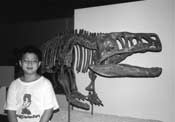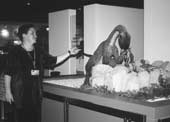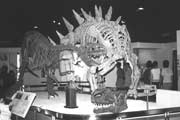From our archives, Compass Magazine, Sep. 2000
Cheryl Robbins
A new special exhibit taking place at the National Museum of Natural Science sets out to make you rethink your concepts about dinosaurs. Five hundred and eighty-three objects, including rare and valuable fossils, reproductions and reconstructed models and skeletons, are used to tackle some of the most perplexing questions about dinosaurs.
The National Museum of Natural Science teamed up with the Institute of Vertebrate Paleontology and Paleoanthropology of the Academia Sinica of mainland China to present “Dancing with Dinosaurs, Millenium Dragon Exhibition”, in celebration of the Year of the Dragon. In Chinese, dinosaur is called ‘kong long’, which means ‘terrible dragon’. The dragon has been an important part of Chinese culture for thousands of years, serving as a symbol of power and good fortune. In addition, fossilized bones of vertebrates, most likely including those of dinosaurs, were originally thought to be ‘dragon bones’. Dragon bones have been ground up and used in Traditional Chinese Medicine since the Spring and Autumn Period (770-476BC) for their calcium and other minerals. Today, more than 100 tons of dragon bones are consumed each year in China and Southeast Asia. As much as China is the ‘Land of the Dragon’ it is also the ‘Land of the Dinosaur’. A number of important dinosaur finds have come from China, as rocks deposited during the time of the dinosaurs were laid down on low plains and near rivers and lakes, providing good preservation conditions for the remains of land vertebrates. The present climate and topography at many of the best dinosaur sites facilitate the discovery and excavation of dinosaur bones. Dinosaur fossils discovered throughout China provide an almost unbroken record of the Age of Dinosaurs (from about 228 million years ago to about 65 million years ago).
Of all of the dinosaur finds from China represented in this exhibit, one not easily missed is the skeleton of Mamenchisaurus hochuanensis. With a length of 22 meters and a height of 13.2 meters, it holds the Guinness World Record for the tallest reconstructed dinosaur skeleton. This dinosaur found in Sichuan Province has a long neck which it used much as giraffes do to feed on the leaves of tall trees. It is an odd-looking creature with a tiny skull and enormous body.
There are many questions left to be answered about dinosaurs, such as how dinosaurs gave birth to young. A number of fossilized dinosaur nests, found in China, are on display. Next to each nest is a model of the dinosaur embryo that would have been found in the eggs of that nest. Compare the sizes of dinosaur eggs to the size of an ostrich egg. Also of interest in this area, is the controversy surrounding Oviraptor. It was originally thought that Oviraptor fed on the eggs of other dinosaurs. But, in a model created from the recent discovery of an Oviraptor adult on top of an Oviraptor nest, it appears that Oviraptor cared for its young, which might serve to improve its tarnished image as an egg stealer. Another question is how dinosaurs hunted and defended themselves. In the center of this exhibit are two fight scenes, one between a stegosaurus and Monolophosaurus (a medium-sized carnivore), and the other between three Velociraptors and the large Tsintaosaurus (measuring up to 10 meters in length). Other exhibit units describe what dinosaurs ate and how they moved.
Another focus of this exhibit is the evolutionary relationship between dinosaurs and birds. The idea that birds are the ancestors of dinosaurs goes back to the 19th century. Supposedly, T.H. Huxley, one of the greatest paleontologists of that time, was carving a turkey one Christmas Day when he noticed the similarity between the anatomy of the turkey and that of the dinosaur fossils in his office. More recent studies have indicated that birds are a group of dinosaurs that evolved feathers. Evidence of this comes from the fossils of a group of feathered dinosaurs of the Jehol Biota in China. These fossils from the late Jurassic (157-100 million years ago) are considered ‘the missing link’ in the evolutionary transition of dinosaurs to birds and the most important paleontological discovery of the past 100 years. These important fossils, on display for the first time in Taiwan, are one of the highlights of this exhibit.
Other interesting displays include two dinosaur leg bones that visitors can touch, and the ‘Nine Dragon Wall’. In Chinese culture, nine types of dragons are represented. But, the Nine Dragon Wall in this exhibit is a replica of a site where nine mammal-like reptiles (Sinokannemeyeria yingchiaoensis) were found buried together. See if you can identify all nine.
You can dance with the dinosaurs from August 15, 2000 to February 15, 2001 in the basement of the Chinese Science Hall of the National Museum of Natural Science. The larger dinosaur skeletons are on display in the courtyard adjacent to the Chinese Science Hall. To protect the specimens, no photography will be allowed. In addition, the number of people entering the exhibit will be limited. So, it is suggested that visits be made during non-peak times to avoid long waits
Museum hours are 9am-5pm Tuesday-Sunday. Admission to this special exhibit is included in the exhibit areas ticket price (adults 100NT, students 70NT). For more information, call the museum at (04)322-6940.









Comments
0 comments